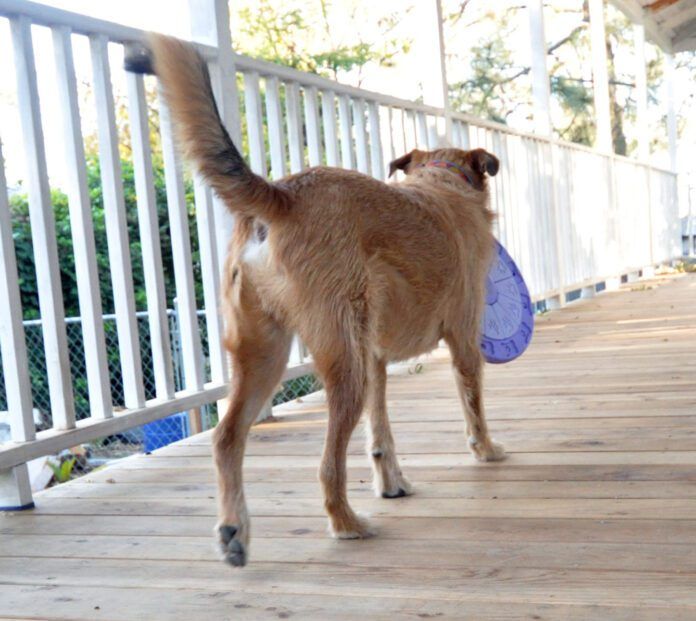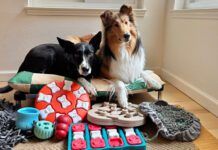There are several types of interactive dog toys that are designed to dispense food in order to engage dogs for extended periods of time. Some are filled with wet food (such as Kongs and Toppls) or covered with wet food (like lick mats) – and are sometimes frozen; the dog has to lick and chew the toy for a long time to extract all the food. Some have a hollow center that can be filled with a mix of kibble or dry treats; the food falls out of the toys through a hole or holes when the dog tosses or rolls the toys around (see the “Kibble-Dribbling” section in “The Best Food-Dispensing Dog Toys”).
The most complex enrichment toys for dogs are what we would call puzzle toys. These are the toys that require dogs to open compartments that are filled with food by manipulating the compartment covers in precise ways, rather than just licking or tossing the toy. The food-compartment covers might slide open – or slide open only after another piece is moved out of the way first. Some open only when the dog pulls on a string or handle, or dispense food when a lever or button is pressed. Some have multiple layers of food-holding compartments, requiring the dog to spin the layers in order to reveal more and more treats.
Whole Dog Journal is reader-supported. If you purchase through links on our site we may earn a commission. Whole Dog Journal does not accept money for its food and product reviews.
What to look for in a dog puzzle toy
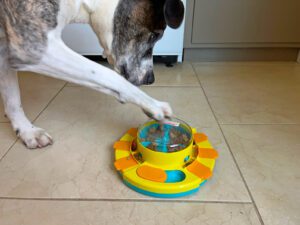
The best dog puzzle toys are those with just the right amount of complexity for the average dog. If they are too easy to empty, your dog will be done eating all the treats before you can walk into the next room, defeating the purpose of proving some enrichment to a bored dog. But if the manipulations required by your dog are too difficult, he may just give up before getting all the treats – or, if he’s anything like my dog Otto, he may resort to destructive techniques rather than nuanced problem-solving. Otto was a great one for just picking up an entire puzzle and throwing it into the air so it would crash onto the floor, spilling treats everywhere.
Ideally, a dog has to use some creativity and persistence to reach all the food in the puzzle toy. And the toy has to be able to survive a creative and persistent dog! We’ve seen some cute, clever puzzle toys that can’t hold up to “real dog” conditions, with parts that can too easily be broken or chewed off. The best toys are sturdy, washable (preferably in a dishwasher!), and don’t require you to help the dog even after he’s learned how to manipulate the puzzle.
Be advised that if a puzzle has a dispensing feature – where, for example, a dog manipulates something to make food pour through a hole – the treats you use will have to fit through those holes easily. Puzzles with compartments that the dog easily accesses can hold food of any kind, but you may have to buy small-sized and/or round kibble for complex toys with dispensing holes or tubes.
Getting the difficulty level right
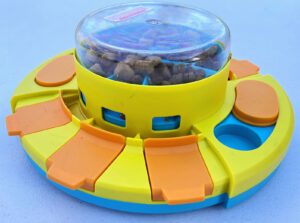
Some dog-puzzle-toy makers rate the difficulty level of their toys, to help owners make buying decisions. For example, Outward Hound, the company that currently makes and sells products designed by Nina Ottosson (the original inventor of dog puzzle toys) identifies its toys and Level 1, 2, 3, or 4:
Level 1: A great way to introduce your pup to problem solving and puzzle games with one-step actions.
Level 2: Has added obstacles that require your dog to combine actions to reach their reward.” One example of Outward Hound’s Level 2 puzzle is the Hide N Slide: The “pegs” covering the treat compartments are easily manipulated to slide open, revealing the treats, but some of the “flippers” must be swiveled aside in order to allow the pegs to move.
Level 3: Challenges your dog to learn sequential steps to find their treat using more complex mechanisms.
Level 4: Requires your dog to complete a series of steps in the correct order for them to earn their treat.
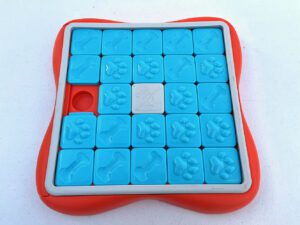
Other dog-puzzle makers use different descriptions of their products’ difficulty – but the point is, you get a sense of your dog’s ability and willingness to solve problems. One dog’s game of tic-tac-toe is another dog’s chess! It’s a good idea to start with an easy puzzle, and watch how your dog deals with it. If he’s easily frustrated and has a difficult time learning how to solve the puzzle, you’ll probably want to stick with the simplest, single-step puzzles. You’re just trying to add enrichment and stimulation to his life, not send him to college! If, in contrast, he is a highly food-motivated puzzle-master whiz-kid, he may be able to skip right to the most difficult puzzles.
It may take some trial and error to find puzzles that will occupy your dog without discouraging him. Fortunately, none of them are that expensive – and you can always gift the too-simple ones to a friend’s or relative’s young puppy, or the too-difficult ones to your closest Border Collie rescue.
How to introduce puzzle toys to your dog
If your dog has never played with puzzle toys before, start with some fairly high-value treats – unless your dog is one of those who will do backflips for kibble. You want him to be motivated enough to work to find the food, but not desperate to reach it at all costs.
Let your dog watch you fill the puzzle’s food-compartments. This will help him get a little excited about the project ahead.
Put the food-filled toy on the floor – preferably a surface that’s not too slick, so your dog doesn’t have to worry about slipping while occupying himself with the puzzle. Allow him to sniff (or paw) at the puzzle; his response will immediately tell you whether you need to show him how to manipulate the puzzle pieces to expose the food, or whether he can reach the food without assistance.
Most dogs start puzzle-solving with their nose and tongue; they can smell the treats inside the toys and will start licking and pushing at the movable parts on the puzzles. Dogs who are naturally more “pawsy” may rely on their paws and claws to try to manipulate the puzzles; again, the best dog puzzle toys will be able to take this sort of treatment without breaking.
Products that require a mixed approach might stymie some dogs. The Kubatis Puzzle Toy, for example, requires dogs to use their noses (to flip up the food-compartment covers) as well as their paws (to press on the top of the toy, which dispenses more treats into the compartments). Once encouraged to press on the top of the toy to dispense more treats, one of our test dogs kept pawing at the somewhat fragile compartment covers, and had to be redirected to using his nose to lift those up, instead.
That brings up our next tip: Be prepared to provide enough supervision to discourage your dog from getting too rough with the toy. Your dog may need to be redirected from taking an inadvertent shortcut to the treats – such as Otto’s throwing the toy across the kitchen to scatter the treats. Some of the toys we tested, such as the Challenge Slider Puzzle Toy from Outward Hound’s Nina Ottosson collection, wouldn’t have survived this treatment without coming apart. (The food-containing tray slides out for easy refilling, but if a dog lifted the entire toy from the ground, it would likely serve him all the treats at once.)
The harder your dog is willing to work for the treats, the lower-value food you can use inside. If he needs more motivation, use a mix of higher-value treats (such as freeze-dried meat cubes or semi-soft treats such as Zukes), kibble, and frozen peas and carrot cubes!


